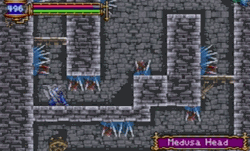 Is Castlevania: Aria of Sorrow the pinnacle of the Igavania legacy?
Is Castlevania: Aria of Sorrow the pinnacle of the Igavania legacy?
Koji Igarashi is widely credited with being responsible for the perennial Castlevania: Symphony of the Night. Where once the Castlevania franchise had been “only” a series of difficult action platforming affairs, Castlevania: SOTN broke the mold and ushered the franchise into a world of maps, secret passages, and more random food items than you could shake a dagger at. Granted, practically everything in Symphony of the Night was already a part of previous Castlevania games (particularly the skeleton sprites), but the IGA-helmed SoTN blended all of these elements into a much more Metroid-y, exploration based affair. It wound up being new, innovative, and, most importantly of all, fun. And, aside from a shocking lack of a boss rush, SoTN was considered to be perfect.
But… how do you improve on perfection?
Castlevania SoTN was followed by Castlevania Legends, and, later, Castlevania: Circle of the Moon. Neither of these games involved Koji Igarashi, but both tried different techniques to bottle the SoTN lightning. Castlevania: Circle of the Moon attempted to ape the Metroidvania gameplay with scattered success, and Castlevania Legends decided to just include SoTN star Alucard to hopefully polish up that turd to a level where it didn’t immediately stink up the joint. It didn’t take. But Circle of the Moon at least made the Igavania a standard piece of the Castlevania puzzle, and didn’t trash the “experiment” like the second adventure of a certain Hyrulian elf.
And then there was Castlevania: Harmony of Dissonance. C:HoD was the first IGA returned to the Castlevania franchise after SoTN, and… well… let’s say he was getting his skeleton legs back. A lot of HoD seems like it was in response to Circle of the Moon, and, right down to the basic “rivals” plot, much of this game feels like “this is how I would have done it.” That’s not necessarily a bad thing, as I’m at least one person that prefers HoD to CotM, but the whole experience still feels rather… shallow. The “chaos castle” is generally bland and a poor excuse to recycle almost the entire map, and, despite some downright charming references to 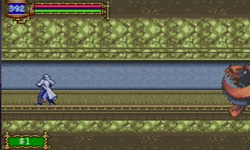 earlier entries in the series, HoD generally feels like a “lesser” Castlevania. Yes, this is what happens when you attempt to convert a Playstation game to a handheld format. Thanks for playing, pray for peace in Wallachia.
earlier entries in the series, HoD generally feels like a “lesser” Castlevania. Yes, this is what happens when you attempt to convert a Playstation game to a handheld format. Thanks for playing, pray for peace in Wallachia.
And then came Castlevania: Aria of Sorrow. Now here’s a proper Igavania.
Except… let’s not talk about that yet.
Let’s talk about what came after Castlevania: Aria of Sorrow. Castlevania: Portrait of Ruin is an Igavania… but it seems much more “level based” with its multiple portrait stages and a castle that is almost perfunctory. Castlevania: Order of Ecclesia took this even further, and the majority of the game is comprised of “levels” that would feel right at home in earlier adventures. Hell, the “castle” of OoE is practically a “bonus” afterthought. And then there’s even Castlevania Aria of Sorrow’s immediate sequel, the bafflingly named Castlevania: Dawn of Sorrow, which superficially follows the Metroid path of its forefathers… but closer examination reveals a number of “level-y” areas, complete with a final series of challenges that barely amount to more than dangerous hallways (or maybe towers).
In short, it seems IGA shifted away from the metroidvania template after Aria of Sorrow. The basic elements were still there, but they generally tapered off until we got “all challenge levels” Castlevania: Harmony of Despair, and no one was surprised.
So why was Aria of Sorrow the end? Well, maybe it’s because it really is the pinnacle of IGA’s intention.
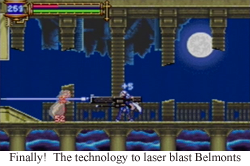 At first blush, Aria of Sorrow doesn’t do anything Symphony of the Night didn’t. You’re a normal quasi-vampire with a sword or two, and you’ve got to explore a castle. Expand your skills as you defeat bosses, eventually gain the ability to turn into a bat, and maybe you’ll see the “secret” ending for finding the right nooks and crannies in this kooky castle. I’m sure there’s some wall meat around here if you get hungry for more.
At first blush, Aria of Sorrow doesn’t do anything Symphony of the Night didn’t. You’re a normal quasi-vampire with a sword or two, and you’ve got to explore a castle. Expand your skills as you defeat bosses, eventually gain the ability to turn into a bat, and maybe you’ll see the “secret” ending for finding the right nooks and crannies in this kooky castle. I’m sure there’s some wall meat around here if you get hungry for more.
But Aria does have more than Symphony. Aria introduced the Tactical Souls System, seemingly the apogee of the “Alucard can equip every damn thing in the castle” system of Symphony. Soma, our hapless hero, can absorb the souls of literally every monster in the castle, and each soul offers a new and interesting ability. Okay, most of the abilities are stupid (do you really need a monster soul to augment your spitting ability?), but there’s always that joy of discovery to be had, and maybe that witch that can’t seem to fly is going to offer a useful ability (answer: yes, she gives you the power of cats!). And, since AoS takes place in the far flung future of two decades from now, all sorts of items are available to Soma, like handguns, RPGs, and even a laser gun. Okay, sure, a legion of lost souls has always had the ability to generate laser blasts, but it’s so much more satisfying when you let loose with a gun that is wider than the protagonist. Couple this with every food item through the whole of human history sitting around Soma’s inventory at any given moment, well, to say the least, Soma has got some options. You could easily play this game a hundred times, and never use the same soul/item combination twice.
And maybe that’s all Koji Igarashi ever wanted.
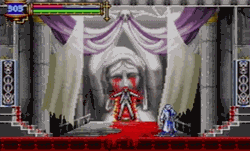 It’s been said before, but, as fun as the Igavania games are, they’re kind of lacking in some design sense. Many areas of many of these games are basic monster gauntlets, and, even going back to SoTN, you can likely point to any random point on the map, and quickly discover a flat hallway that is “only” a series of indistinct monsters. And, while part of the appeal of these Igavanias is that we’ve left the plodding Belmonts in the dust, even at top speed, you’re likely to cut through these dreary hallways again and again. One could easily argue that a “good” Metroidvania should be more… interesting. Look at Super Metroid, look at all the creativity that goes into any given room on that planet… or just consider how a speed booster equipped Samus Aran would absolutely destroy 90% of Alucard’s greatest adventure.
It’s been said before, but, as fun as the Igavania games are, they’re kind of lacking in some design sense. Many areas of many of these games are basic monster gauntlets, and, even going back to SoTN, you can likely point to any random point on the map, and quickly discover a flat hallway that is “only” a series of indistinct monsters. And, while part of the appeal of these Igavanias is that we’ve left the plodding Belmonts in the dust, even at top speed, you’re likely to cut through these dreary hallways again and again. One could easily argue that a “good” Metroidvania should be more… interesting. Look at Super Metroid, look at all the creativity that goes into any given room on that planet… or just consider how a speed booster equipped Samus Aran would absolutely destroy 90% of Alucard’s greatest adventure.
But maybe that was never the point.
Maybe the point has always been all the wild “crap” that could be squeezed into any given corner. Maybe it’s not about appealing room layouts, but the interesting inhabits of those rooms, whether they be psycho maids or waiter skeletons. Maybe it’s about going through that same stupid hallway over and over again, but every time you return, you’ve got a new ability to try out. No, the latest iteration of the fireball or the ability to hover mid jumpkick isn’t going to make the traversal any faster or easier, but it could make things a tweak more exciting. Maybe it’s not about seeing the same stupid skeleton continually, but seeing just how many ways you can mangle those bags o’ bones. Maybe it was never about 100% completion, or uncovering every last bit of the map, or finding the fastest route to (not) Dracula. Maybe it was about something else all this time.
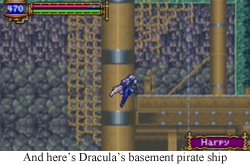 And maybe, having crammed so much into Aria of Sorrow, Koji Igarashi felt content, and decided to move onto other challenges. Going forward, maybe he wanted to join the best of the old with the wonder of his new, and the later Igavanias were born. Maybe Aria of Sorrow was the top, and from there, only dissimilar challenges remained.
And maybe, having crammed so much into Aria of Sorrow, Koji Igarashi felt content, and decided to move onto other challenges. Going forward, maybe he wanted to join the best of the old with the wonder of his new, and the later Igavanias were born. Maybe Aria of Sorrow was the top, and from there, only dissimilar challenges remained.
Or maybe I’m just happy we finally got a decent boss rush. Hey, whatever makes a game good.
FGC #224 Castlevania Aria of Sorrow
- System: Gameboy Advance and WiiU Virtual Console. Has anyone picked up any GBA games on the WiiU? Is the emulation any good? I’m still using my Gamecube player over here.
- Number of players: One Soma. Maybe a Julius, but still just one.
- Favorite Soul: Waiter Skeleton allows Soma to toss curry at monsters. I like curry. I also like that all monsters seem to target the curry, so you can actually use the curry to effectively manage some of the more crowded challenge rooms.
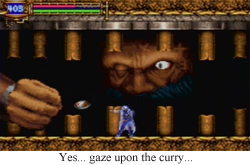 Go get yer dinner, Balore!
Go get yer dinner, Balore! - Favorite Boss: In this case, it has to be Julius Belmont. Unlike battles with Richter in SoTN or… Richter again in Portrait of Ruin, this Belmont battle feels right, less like an easter egg and more like the typical Dracula battle… except maybe from the wrong side. Just watch out for that cross special.
- Favorite Weapon: Excalibur, the legendary sword in the stone… is still in its stone. Cute.
- Did you know? The plot of this game is based on an actual Nostradamus prophecy regarding a great evil coming to power in 1999. Dude was off by eighteen years, but, still, pretty good for a guy from World Heroes.
- Would I play again: I love this game. And every time I play it, I have to play…
What’s next? Random ROB is taking a backseat so I can play… Castlevania Dawn of Sorrow for Nintendo DS! What? I have to play the sequel after the original. It’s only proper. Please look forward to it!
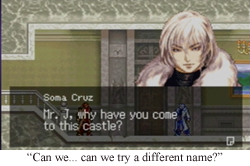
I’ve played GBA games on Wii U and I can confirm the emulation is much better than what you’d get from a Game Boy Player.
And yeah, I’m a HoD > CotM guy, too. Circle had some neat spells and aesthetics going for it, but Harmony just flows so, so much better. Shame most of the bosses and loot are a joke.
I like SotN a little more in some ways (Palette swapped capes! Shield Rod! Sword of Dawn! Cool boss and background designs! Peanuts! Familiars with levels! Duplicator!), but Aria is definitely a favorite of mine. Many of the bullet souls are hard to recommend over a good whacking stick, but there’s plenty of neat stuff to play with.
Also New Game Plus being a thing is nice. Wish SotN had one of those.
“Many of the bullet souls are hard to recommend over a good whacking stick” Definitely. Maybe if they didn’t cost so much MP. Or if they didn’t cost MP if you missed.
Aria is still a pretty good game. I have only played it and SotN so I can’t speak to any of the other games mentioned.
[…] stomps through the Castlevania countryside. And… Oh! What’s this? We all had so much fun with Soma Cruz and his ability to manipulate Dracula’s powers that we are getting a whole new Castlevania […]
[…] Now he’s back from the dead, and he’s got…. let’s see here, what would be threatening… a laser rifle! How ever will ancient hero with his ancient ways win this one!? Heck, you don’t even have to get […]